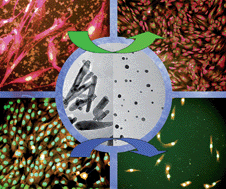Recent developments in biomineralization and biomaterials have demonstrated that nano-calcium phosphate particles play an important role in the formation of hard tissues in nature. It is suggested that the basic inorganic building blocks of bone and enamel are nanosized apatite although their hierarchical structures differ. Nanoparticles can confer on biominerals remarkable physical and chemical characteristics such as enhanced mechanical strength and self-preservation in biological fluids. In living organisms, tens to hundreds of nano-blocks, under the control of an organic matrix, combine into self-assembled biominerals. It is also confirmed experimentally that enamel- or bone-like apatite can be achieved by oriented aggregation by using nano-calcium phosphates as the raw materials, determined by the biomolecules. Interestingly, features of smaller hydroxyapatite (HAP) nanoparticles may more closely approximate features of HAP during biomineralization than features of the larger HAP particles that are conventionally used. The application and prospective use of nano-calcium phosphate in the biological repair of bone and enamel are also introduced. It is emphasized that the cell experiments reveal improved cytophilicity of nanophase calcium phosphate minerals. Greater cell viability and proliferation of bone marrow mesenchymal stem cells are measured on smaller calcium phosphates. Furthermore, studies of amorphous calcium phosphate and crystallized HAP particles are used to investigate the effect of crystallinity of nanoparticles on living cells, and show that the differentiation of stem cells is promoted significantly by nano-HAP. It is suggested that nano-HAP may be the ideal biomaterial due to its good biocompatibility and bone/enamel integration. Lots of studies of calcium phosphates are expected in the nano-zone such as for drug delivery systems and resorbable scaffolds. In this feature article, a new view on calcium phosphates highlights the importance of size and phase controls in the application of biomedical materials.

You have access to this article
 Please wait while we load your content...
Something went wrong. Try again?
Please wait while we load your content...
Something went wrong. Try again?


 Please wait while we load your content...
Please wait while we load your content...